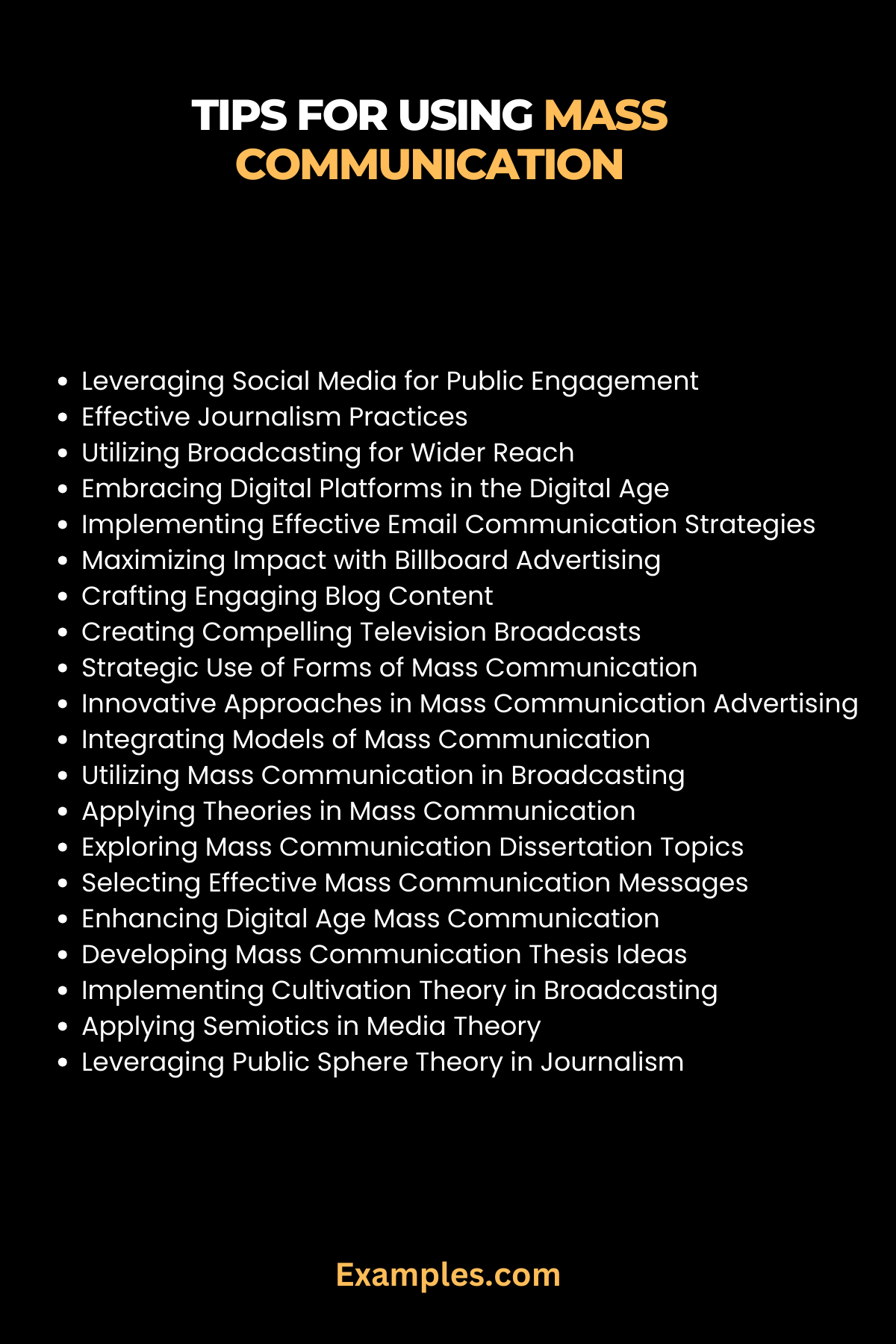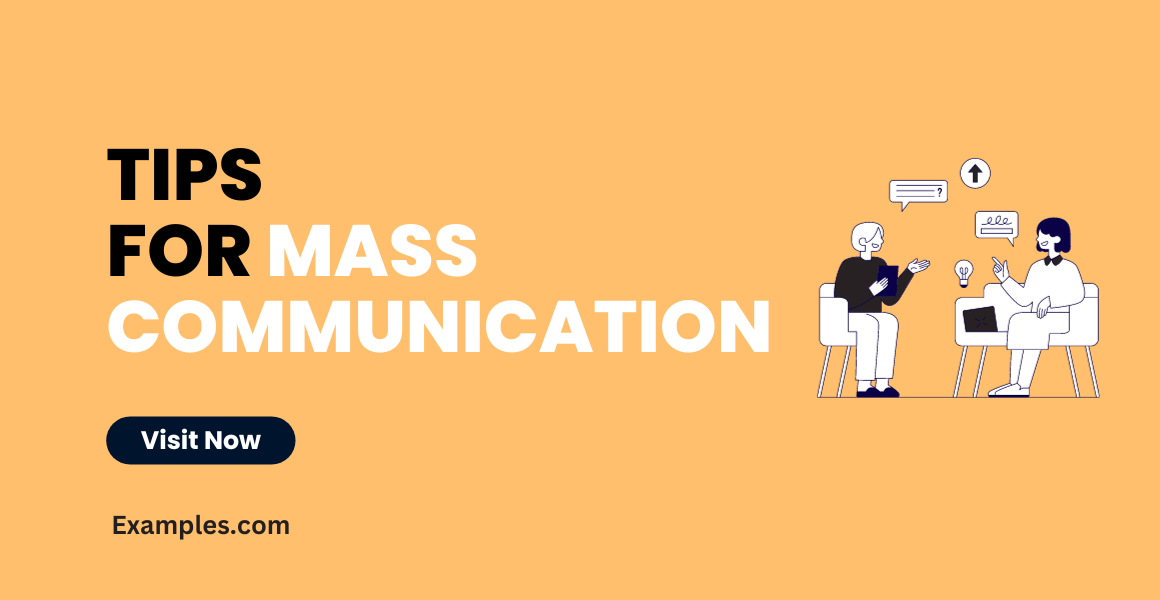Tips for Mass Communication
Navigate the dynamic world of mass communication with our comprehensive guide, filled with essential tips. This guide is a valuable resource for anyone looking to master the art of conveying messages effectively to a wide audience. From understanding the nuances of digital platforms to crafting impactful content, our tips cover various aspects of mass communication. Ideal for professionals, students, and enthusiasts, this guide offers practical advice to enhance your communication strategies and reach your audience more effectively.
Tips for Using Mass Communication in Healthcare?
In healthcare, effectively utilizing mass communication involves understanding and addressing the diverse needs of patients. Tailor your messaging to various demographics, ensuring clarity and accessibility, particularly for complex medical information. Embrace a range of channels, from traditional Broadcasting Mass Communication to digital platforms like Email Mass Communication and social media, to disseminate health tips, appointment reminders, and policy updates. Regular, clear communication is vital, especially in crisis situations, adhering to established crisis communication principles. Engaging, educational content delivered through these channels can significantly enhance patient knowledge and healthcare outcomes.

1. Understanding Patient Demographics
In healthcare, it’s crucial to understand the demographics of your patient population. Tailoring Mass Communication messages to suit different age groups, cultural backgrounds, and health literacy levels ensures effective communication.
2. Utilizing Various Communication Channels
Employ a range of communication channels like Email Mass Communication, patient portals, and social media to reach patients. Each channel can be used for different types of messages, from health tips to appointment reminders.
3. Focusing on Clear, Accessible Messaging
Ensure all communication is clear and jargon-free. Utilizing the Limited Effects Theory, which suggests that media influence is often less powerful than personal influence, emphasizes the importance of straightforward, comprehensible information.
4. Engaging Through Social Media
Use Social media Mass Communication to engage with patients and the community. Share health tips, medical news, and wellness resources. This approach aligns with the Two-Step Flow Theory, where information is passed from media to opinion leaders and then to a wider audience.
5. Regular Updates and Information Sharing
Keep patients informed about new services, health policies, and medical advancements through regular newsletters and updates. This aligns with the Media Dependency Theory, where the audience relies on media for information.
6. Promoting Health Education
Use mass communication tools to educate patients about disease prevention, healthy lifestyles, and medical procedures. Educational videos, infographics, and webinars can be particularly effective.
7. Implementing Crisis Communication Plans
In emergencies, have a crisis communication plan in place. Use mass media to provide timely, accurate information about health crises or emergencies, following the Crisis Communication strategies.
Tips for Using Mass Communication for Students?
In using mass communication for students, it’s essential to focus on digital platforms that resonate with a younger, tech-savvy audience. Platforms like educational blogs, social media, and online forums are ideal for engaging students interactively and visually. Content should be relevant, informative, and aligned with their interests and current academic topics. Incorporating multimedia elements like videos, podcasts, and infographics can enhance learning and retention. Regularly updating educational resources and maintaining interactive communication channels encourages student participation and fosters a dynamic learning environment.

1. Leveraging Digital Platforms for Engagement
Utilize digital platforms like educational apps and online forums to engage students. These platforms are ideal for Digital Age Mass Communication, providing interactive and engaging content.
2. Creating Interactive and Relevant Content
Develop content that is both interactive and relevant to students’ interests and current events. This approach follows the Uses and Gratifications theory, as it caters to the users’ needs for information, entertainment, and social interaction.
3. Using Social Media for Educational Purposes
Employ Social media Mass Communication to create educational content that is shareable and engaging. Platforms like YouTube or educational blogs can be used for disseminating informative content.
4. Emphasizing Visual Learning
Incorporate visual elements like infographics and videos in communications, as they can enhance understanding and retention, especially for complex subjects, following the principles of the Media Richness Theory.
5. Encouraging Collaborative Learning
Promote collaborative learning through online platforms where students can work together on projects and share ideas, in line with the Social Learning Theory.
6. Regular Updates on Educational Resources
Provide students with regular updates about educational resources, events, and opportunities through emails, newsletters, or a dedicated student portal.
7. Implementing Feedback Mechanisms
Establish feedback mechanisms to gauge student engagement and understanding. Online surveys and interactive Q&A sessions can provide valuable insights
Tips for Using Mass Communication

1. Leveraging Social Media for Public Engagement
In Social media Mass Communication, it’s crucial to engage your audience with compelling content. Use platforms like Twitter or Instagram to interact with your audience, share relevant information, and respond to feedback. This approach aligns with the Two-Step Flow Theory, where opinion leaders disseminate information to a broader audience.
2. Effective Journalism Practices
Journalism Mass Communication demands accuracy and integrity. Stay true to Journalism Mass Communication principles by verifying information and sourcing accurately. This practice is in line with the Gatekeeping Theory, ensuring that only verified and significant information reaches the public.
3. Utilizing Broadcasting for Wider Reach
In Broadcasting Mass Communication, the aim is to reach a wide audience. Television and radio are powerful tools for this. Tailor your content to be engaging and informative, making sure it resonates with a diverse audience, following the principles of the Uses and Gratifications theory.
4. Embracing Digital Platforms in the Digital Age
Digital Age Mass Communication has transformed how we disseminate information. Utilize digital platforms like blogs and podcasts to reach a tech-savvy audience. This approach aligns with the Media Dependency Theory, where the audience depends on digital media for information.
5. Implementing Effective Email Communication Strategies
In Email Mass Communication, clarity and conciseness are key. Use email for targeted communication, ensuring messages are straightforward and relevant. This aligns with the Information Theory, focusing on the effective transmission of information.
6. Maximizing Impact with Billboard Advertising
Billboard Mass Communication is about visual impact. Design billboards that are visually striking and convey a clear message at a glance. This method ties in with the Elaboration Likelihood Model, focusing on the peripheral route of persuasion.
7. Crafting Engaging Blog Content
In Blog Mass Communication, engaging and relevant content is paramount. Use blogs to provide in-depth insights, personal narratives, or expert opinions, reflecting the principles of the Narrative Paradigm Theory.
8. Creating Compelling Television Broadcasts
Television Mass Communication should be both informative and entertaining. Craft content that captures and retains audience attention, making use of the Cultivation Theory to influence and inform viewers’ perceptions.
9. Strategic Use of Forms of Mass Communication
Understanding different Forms of Mass Communication allows for a more strategic approach. Tailor your message to suit the medium, whether it’s print, digital, or broadcast, ensuring maximum reach and impact.
10. Innovative Approaches in Mass Communication Advertising
In Mass Communication in Advertising, creativity is crucial. Develop innovative campaigns that captivate and persuade your audience, making use of theories like the Framing Theory to shape how the audience perceives your message.
11. Integrating Models of Mass Communication
Incorporate different Models of Mass Communication for a comprehensive strategy. Utilize models like the Encoding/Decoding Model to understand how audiences interpret messages, ensuring your communication is effective and resonates with diverse groups.
12. Utilizing Mass Communication in Broadcasting
Maximize the impact of Mass Communication in Broadcasting by focusing on audience engagement and quality content. This approach should align with the Agenda-Setting Theory, where the media’s focus influences public perception and priorities.
13. Applying Theories in Mass Communication
Use various Mass Communication Theories to guide your strategies. Theories like the Spiral of Silence Theory can help in understanding public opinion trends and shaping your communication to address or challenge these trends.
14. Exploring Mass Communication Dissertation Topics
For those researching Mass Communication Dissertation Topics, delve into areas like digital media’s impact on public opinion, aligning with theories like the Social Learning Theory which highlights the influence of media on learning and behavior.
15. Selecting Effective Mass Communication Messages
Craft Mass Communication Messages that are clear, concise, and impactful. Align your messaging strategy with the Selective Exposure Theory, ensuring your content aligns with the preferences and beliefs of your target audience.
16. Enhancing Digital Age Mass Communication
In the Digital Age Mass Communication, focus on interactivity and multimedia content. Use platforms that allow for two-way communication and audience engagement, following the Media Richness Theory for more effective and nuanced communication.
17. Developing Mass Communication Thesis Ideas
When working on Mass Communication Thesis Ideas, consider studying the effects of social media on global communication dynamics, guided by the Global Village Theory, which examines the world’s interconnectedness through media.
18. Implementing Cultivation Theory in Broadcasting
Use the Cultivation Theory in Broadcasting Mass Communication to understand how long-term exposure to media content shapes viewers’ perceptions of reality, guiding content creation to be more mindful of its potential impact.
19. Applying Semiotics in Media Theory
In Semiotics in Media Theory, analyze the symbols and signs in media content. This approach is crucial in understanding how visuals and language in media influence audience interpretation and reaction.
20. Leveraging Public Sphere Theory in Journalism
In Journalism Mass Communication, adopt the Public Sphere Theory to facilitate open and democratic discussions. Focus on journalism that encourages public debate and contributes to an informed citizenry.
Effectively leveraging mass communication requires a blend of strategic planning, audience understanding, and creative content delivery. Whether it’s through traditional media like broadcasting and print or modern channels like social media and digital platforms, the key is to craft messages that resonate with and engage your audience. Staying abreast of the latest trends, technologies, and communication theories can enhance the impact of your efforts. Remember, in the diverse world of mass communication, the ability to adapt and respond to the evolving media landscape is essential for success.



